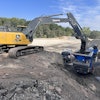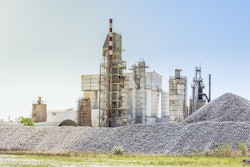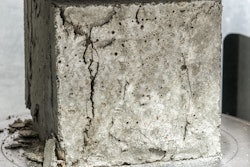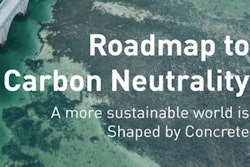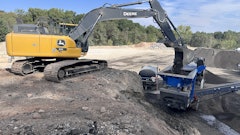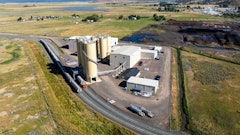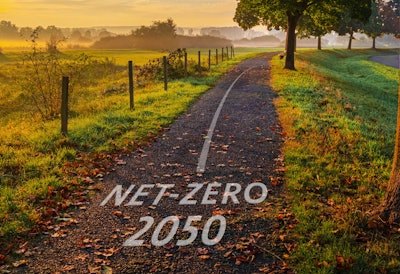
Asphalt pavements make up 93% of the U.S. pavement infrastructure. We know that the cement and concrete industry have come out with a plan about what they're going to do to achieve net neutrality and their carbon future, and the asphalt industry is there now too.
The National Asphalt Pavement Association (NAPA) has unveiled "The Road Forward" vision for net zero carbon emissions which includes goals to help the asphalt industry take action.
"We believe that, over the next several decades, reducing carbon emissions will be the country's foremost imperative, persisting even amid changing political or economic situations," Richard Willis, vice president engineering, research and technology at NAPA says. "The asphalt industry is committed to being a part of the solution and we are working towards achieving net zero carbon emissions by 2050. Corporate support will pave the way toward innovation and implementation of net zero carbon emissions solutions."
NAPA unveiled "The Road Forward" initiative at their 2022 annual meeting in Phoenix, AZ and indicated that their mission would be to engage, educate and empower the asphalt community to produce and construct net zero carbon emission asphalt pavements. The industry is well-positioned to make these changes and continue to be the pavement choice of the future and here are some reasons why.
Recyclability
Asphalt is America’s most recycled material, and asphalt mixes containing reclaimed asphalt pavements (RAP) have been in place and performing for many decades.
89.2 million tons of RAP are used annually in new asphalt pavement construction in the United States. The net reduction of greenhouse gas emissions from the use of RAP in new asphalt mixtures from 2009 to 2019 was estimated at 21.2 million tonne CO2e. To put this in perspective, this is equivalent to the annual emissions from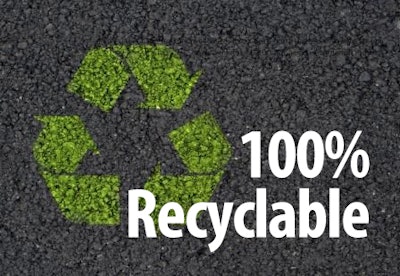
Cost savings are another factor for recycling pavements. Every year, $3.3 billion are saved by using RAP – making asphalt pavement both environmentally and economically sustainable. Nationally, NAPA says the average 21.1% RAP used in new asphalt mixtures saved $7.80 per ton, compared to mixtures using all virgin materials.
Recycling is just one reason that asphalt is the most sustainable pavement. Asphalt pavements that are designed and constructed as "Perpetual Pavements" never need to be removed and replaced. According to research by the Federal Highway Administration (FHWA), perpetual pavements over their life cycle they are 17 to 20 percent cheaper than a traditional asphalt pavement to maintain.
Warm Mix Asphalt
In 2010, FHWA made warm-mix asphalt part of its Every Day Counts initiative to speed the deployment of technologies that can improve highway projects' quality, sustainability and safety. Using warm-mix asphalt (WMA), allows producers to lower the temperatures at which the material is mixed and placed on the road. Reductions of 50° to 100° F have been documented and have the obvious benefits of cutting fuel consumption and decreasing the production of greenhouse gases.
On average, contractors report energy savings of almost 25 percent during warm-mix production. When WMA is fully implemented across the industry, the U.S. will save an estimated 150 million gallons of No. 2 fuel oil per year, while also slashing carbon dioxide emissions by an equivalent of 210,000 cars annually. In addition, engineering benefits include better compaction on the road, the ability to haul paving mix for longer distances and extending the paving season by being able to pave at lower temperatures.
Construction giant Balfour Beatty says the building and infrastructure sector supply chain will have a vital role in helping meet net zero commitments. Balfour Beatty has made the switch to warm mix asphalt in road construction, having worked closely alongside National Highways, main contractors, suppliers and designers, to identify that a 15% carbon saving could be achieved. 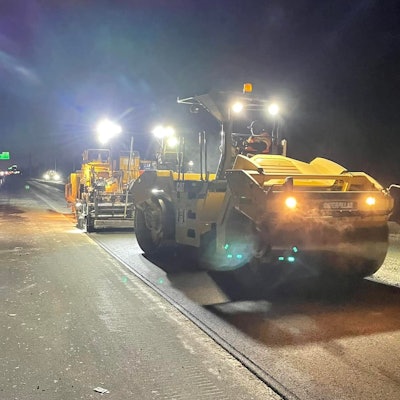 Paving with asphalt cuts construction project time significantly and eliminates the long curing times of concrete.
Paving with asphalt cuts construction project time significantly and eliminates the long curing times of concrete.
Speed of Construction
Paving with asphalt cuts construction project time significantly and eliminates the long curing times of concrete. As a result, traffic flows more smoothly, impact on commerce is minimized and safety hazards are reduced. In one state highway department comparison, asphalt crews placed more than 10 times the pavement surface that a concrete contractor did. The asphalt was placed in 11 nighttime-only shifts, while the concrete work went on around the clock for 12 days.
Reducing the time to complete projects, means there is less equipment working fewer hours, reducing emissions and energy consumption. Smart planning — including increasing roadway capacity and maintaining the pavement surface — along with the swift construction possible with asphalt can help address the $170 billion U.S. motorists lose to traffic delays.
Reduced Fuel Consumption
In the industry, we know that asphalt roadways are the smoother option for drivers, but these smooth pavements actual add up to real cost savings.
A smooth roadway not only provides drivers with peace of mind, it also increases vehicle fuel efficiency. While manufacturers make strides to improve an automobile’s fuel economy, transportation agencies, researchers and engineers are concurrently working to refine and build smooth roadways that do the same.
All told, Americans burn 175 billion gallons of fuel driving approximately 3 trillion miles a year. If roads across the nation were smoother and maintained in good condition, approximately 4 percent of the fuel consumed could be saved, reducing annual vehicle fuel consumption by about 7 billion gallons — the equivalent of taking more than 10 million vehicles off the road every year.
Environmental Product Declarations
As the industry moves towards more stringent green initiatives, Environmental Product Declarations (EPDs) will begin to play a major part in the construction process. EPDs are standardized ways of reporting the life-cycle environmental impacts of products. EPDs are like a “nutrition label” for products that report a selection of environmental impacts. This is similar to the nutrition labels on food, which report the measured nutrition facts for the food product. EPDs are third party verified and need to follow ISO 14025 guidance and procedures.
Eight states are currently looking at or already implementing EPDs for the project procurement cycle. In fact, in New York and New Jersey, the Port Authority has already implemented it, and they basically did it overnight.
The asphalt industry is working towards creating EPDs for asphalt mixtures and NAPA has a tool that is available it's something you need to start being aware of. Created by industry professionals and stakeholders and evaluated by sustainability experts, NAPA's Emerald Eco-Label EPD tool was developed in conformance with ISO 14025 and EN 15804, which establish principles and procedures for developing a Type III environmental declaration program and describes the potential environmental impacts of a product.
The Road Forward
Our industry continuously explores methods and practices to contribute to a sustainable infrastructure and a healthy environment for generations to come. To achieve a net zero emission industry, we need to all work together to understand the key drivers of asphalt production and construction emissions and find ways to reduce them. NAPA has set four industry goals for Climate Stewardship Toward Net Zero Carbon Emissions and laid out plans for the industry to take action now.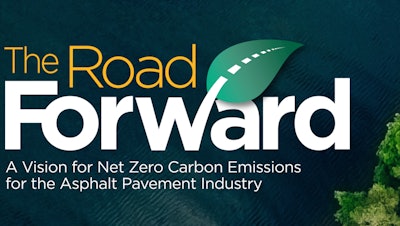 National Asphalt Pavement Association
National Asphalt Pavement Association
Over the past year, the 21-member Climate Stewardship Task Force studied the issue carefully to craft a direction for the industry. The result is The Road Forward – a mission, vision, and roadmap outlining the direction the industry needs to take over the next two decades in the pursuit of net zero carbon emissions in the production of asphalt pavements. It includes four goals, 19 tactics, and eight research and implementation gaps.The four goals are:
1. Achieve net zero carbon emissions during asphalt production and construction by 2050
WHAT IT MEANS
The industry will, on a net basis, not contribute any carbon emissions from its own operations (e.g., materials, equipment). Many countries, industries, and companies worldwide are pledging to reach net zero carbon emissions by 2050 — a goal echoed by the asphalt pavement industry.
2. Partner with customers to reduce emissions through pavement quality, durability, longevity, and efficiency standards by 2050
WHAT IT MEANS
The asphalt industry relies on customers and stakeholders to achieve net zero carbon emissions. Owners must ask for products and implement practices that lead to net zero emissions. NAPA has committed to partnering with stakeholders to achieve a sustainable business case for these actions.
3. Develop a net zero materials supply chain by 2050
WHAT IT MEANS
Supplier partnerships and net zero commitments are critical for the industry to achieve net zero carbon emissions. What the industry asks of and gets from its suppliers counts toward its own net zero goal.
4. Transition to electricity from renewable energy providers in support of net zero carbon electricity generation by 2050 and reduce electrical intensities
WHAT IT MEANS
The power generation industry is moving toward net zero carbon, which the asphalt industry can leverage to reduce its own emissions.
NAPA has dedicated a section of its website, AsphaltPavement.org, to The Road Forward. It is accessible via AsphaltPavement.org/Forward.
The Environment Is Everyone’s Responsibility
To make meaningful advancements, The Road Forward includes the entire U.S. asphalt community – from members and suppliers to road owners.
“As a multi-generational, family-owned company, we’re not being pressured by investors and customers to do this. We’re taking the initiative ourselves,” said Dan Gallagher, President of Gallagher Asphalt Corp. and Vice Chair of NAPA’s Climate Stewardship Task Force. “Because when I think about my children and grandchildren, I know this is what we need to do for our families, our communities, our companies, and our industry.”
Best-selling author on megatrends, Andrew Winston, said in his keynote address to NAPA’s Annual Meeting attendees, “This is systems change. You have companies setting goals in all sectors for their suppliers. We cannot get there without each other.”
Willis added, “I encourage everyone to learn the terminology and understand the impacts. Every single person makes a difference in how we move forward.”
Gallagher agreed, “Each of us has a role to play and a responsibility to act now.”
It's a long road ahead to net zero in the asphalt industry, but the change is coming and we all need to commit to doing it together. Thank you to NAPA for your continued dedication to advancing our industry.



